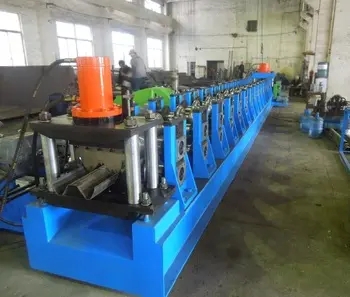
The Trapezoid Roof Sheet Roll Forming Machine A Comprehensive Overview
In the construction industry, the demand for durable, cost-effective, and aesthetically pleasing roofing materials has steadily increased. As a result, the trapezoid roof sheet roll forming machine has emerged as a vital piece of equipment for manufacturers looking to produce high-quality roofing sheets efficiently. This article explores the features, benefits, and operational principles of the trapezoid roof sheet roll forming machine.
What is a Trapezoid Roof Sheet Roll Forming Machine?
A trapezoid roof sheet roll forming machine is specialized machinery designed to convert metal coils into trapezoid-shaped roofing sheets. These sheets are characterized by their unique trapezoidal profile, which provides excellent structural strength while allowing for efficient water drainage. The machine uses a series of rollers to shape the metal as it passes through, creating uniform profiles that are perfect for commercial and residential roofing applications.
Key Features
1. Roller Configuration The machine consists of multiple rollers arranged in a specific sequence to achieve the desired trapezoidal shape. The roller design is crucial to ensuring a consistent profile and high production efficiency.
2. Hydraulic Cutting System To achieve precise lengths for each sheet, many trapezoid roof sheet roll forming machines incorporate a hydraulic cutting system that operates after the forming process. This ensures that all sheets are cut to exact specifications.
3. Control System Modern machines are equipped with advanced control systems that allow for easy operation and adjustment. Programmable logic controllers (PLCs) can facilitate automated production processes, reducing labor costs and errors.
4. Durable Construction Given that these machines work with metal materials, they are built to withstand heavy-duty operations. High-quality steel components and robust construction ensure longevity and reliability.
Benefits of Using Trapezoid Roof Sheets
The trapezoid roof sheets produced by these machines offer several advantages. First and foremost, their unique design enhances structural integrity, making them resistant to wind uplift and other environmental stresses. Additionally, the profile allows for quick water drainage, reducing the risk of leaks and water damage.

Moreover, trapezoid roof sheets are lightweight, which eases the burden on supporting structures. This can lead to cost savings during construction, as less support material may be required. Furthermore, the sheets can be coated with anti-corrosive materials, extending their lifespan and maintaining aesthetic appeal over time.
Applications
Trapezoid roof sheets are widely used in various applications. They are popular in industrial buildings, warehouses, residential homes, and agricultural structures. Their versatility makes them suitable for different roofing styles, and they can be easily customized to meet specific design requirements.
Operational Principles
The operation of a trapezoid roof sheet roll forming machine typically involves several steps
1. Feeding The metal coil is fed into the machine. The feeding mechanism ensures that the coil is properly aligned for consistent sheet production.
2. Forming As the metal passes through the series of rollers, it begins to take shape, forming the trapezoidal profile. The rolling process applies gradual pressure to avoid damaging the material.
3. Cutting After the desired length is reached, the hydraulic cutting system activates, precisely cutting the sheet to the required dimensions.
4. Output Finally, the finished trapezoid roof sheets are ejected and can be collected for further handling or storage.
Conclusion
The trapezoid roof sheet roll forming machine plays an integral role in the production of modern roofing materials. With its advanced features and capabilities, it allows manufacturers to produce strong, durable, and attractively designed trapezoid roof sheets efficiently. As the construction industry continues to evolve, this machine will undoubtedly remain a cornerstone of roofing sheet production, meeting the growing demands for quality and performance in roofing applications.